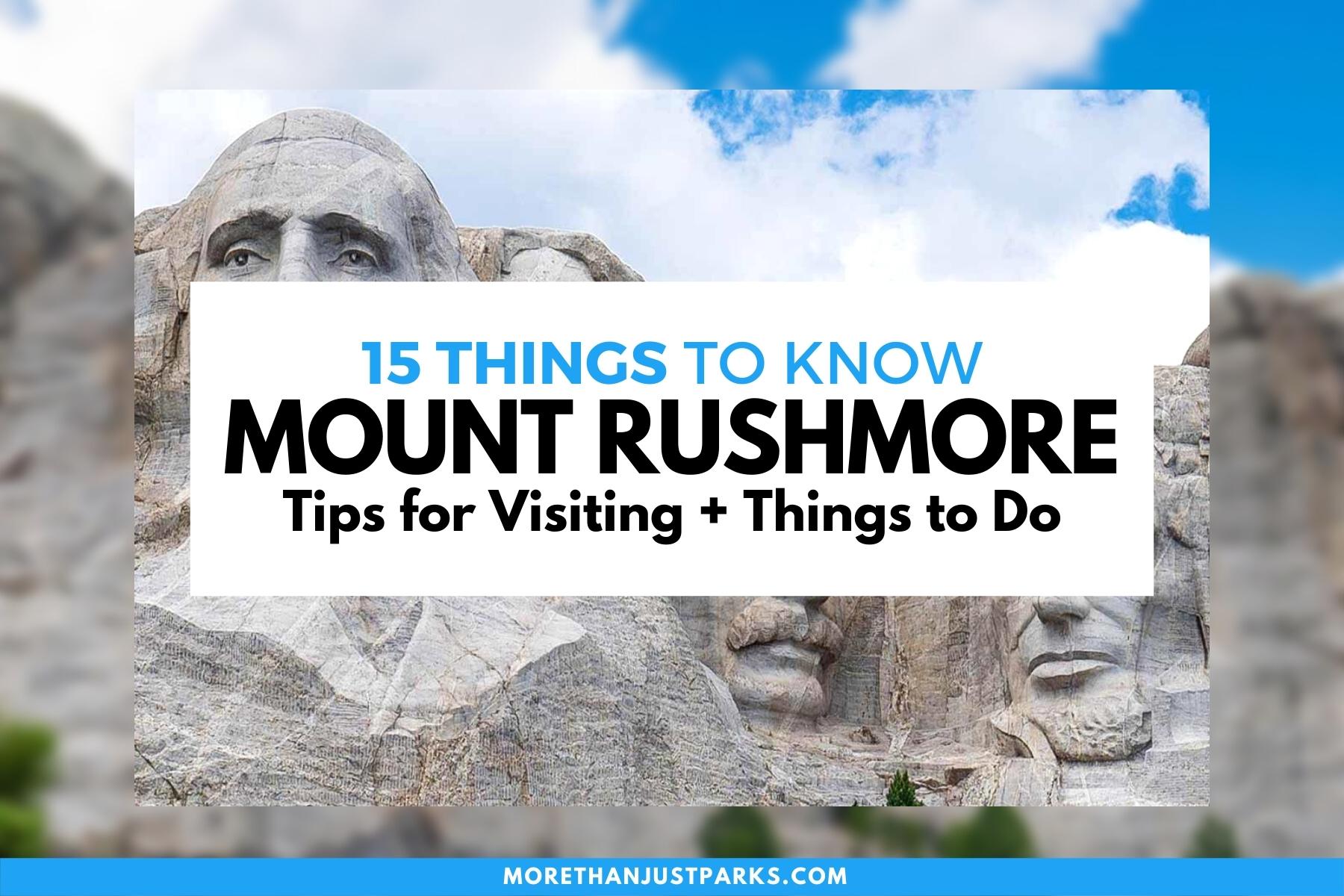
Visiting Mount Rushmore was a long time bucket list item for me having seen this iconic location in photos, movies, and on TV growing up.
Its somewhat remote location in South Dakota long kept me from seeing it (as someone who grew up in the Southeastern United States).
I had several friends and family members visit Rushmore prior to my visit and heard a myriad of reviews from life-changing to disappointing.
Finally I was able to visit Mount Rushmore and I was certainly surprised in many ways by what I saw but not in the least bit disappointed.
In this article I’ll cover the following based on my (now numerous) visits to Mount Rushmore:
- What to Know for Visiting Mount Rushmore
- Things to Do at Mount Rushmore
- Things to Do Near Mount Rushmore (there’s a lot!)
- Interesting Mount Rushmore Facts
- The Mount Rushmore Controversy
- Best Time to Visit Mount Rushmore (including when its open vs closed)
- Information on the Black Hills of South Dakota
- Mount Rushmore Attractions
I’ll be mixing in things to know with things to do at Mount Rushmore National Memorial. Ready to go? Let’s dive in!
Visiting Mount Rushmore
15. Things to Know Before You Visit Mount Rushmore
Entrance Fees: Good news here! Mount Rushmore does not charge an entrance fee for visitors. However, there is a parking fee which is $10 per vehicle.
National Parks Pass? If you plan to visit more National Parks within the next 12 months we suggest you go ahead and purchase the America the Beautiful Pass (which can be purchased at any national park) and gets you into all National Parks, Forests, Monuments, and more including 2,000 sites for free after a one time $79 fee.
The best map for the park: We like this map the best.
The best guide books for Mount Rushmore: This is our favorite all around guide for visting Mount Rushmore.
Cell Service is pretty reliable in Mount Rushmore. Verizon is pretty reliable – AT&T less so.
Where is Mount Rushmore Located?
Mount Rushmore is located in the Black Hills region of South Dakota.
Closest Airport to Mount Rushmore: The closest airport to Mount Rushmore is Rapid City Regional Airport which services most major US airlines daily.
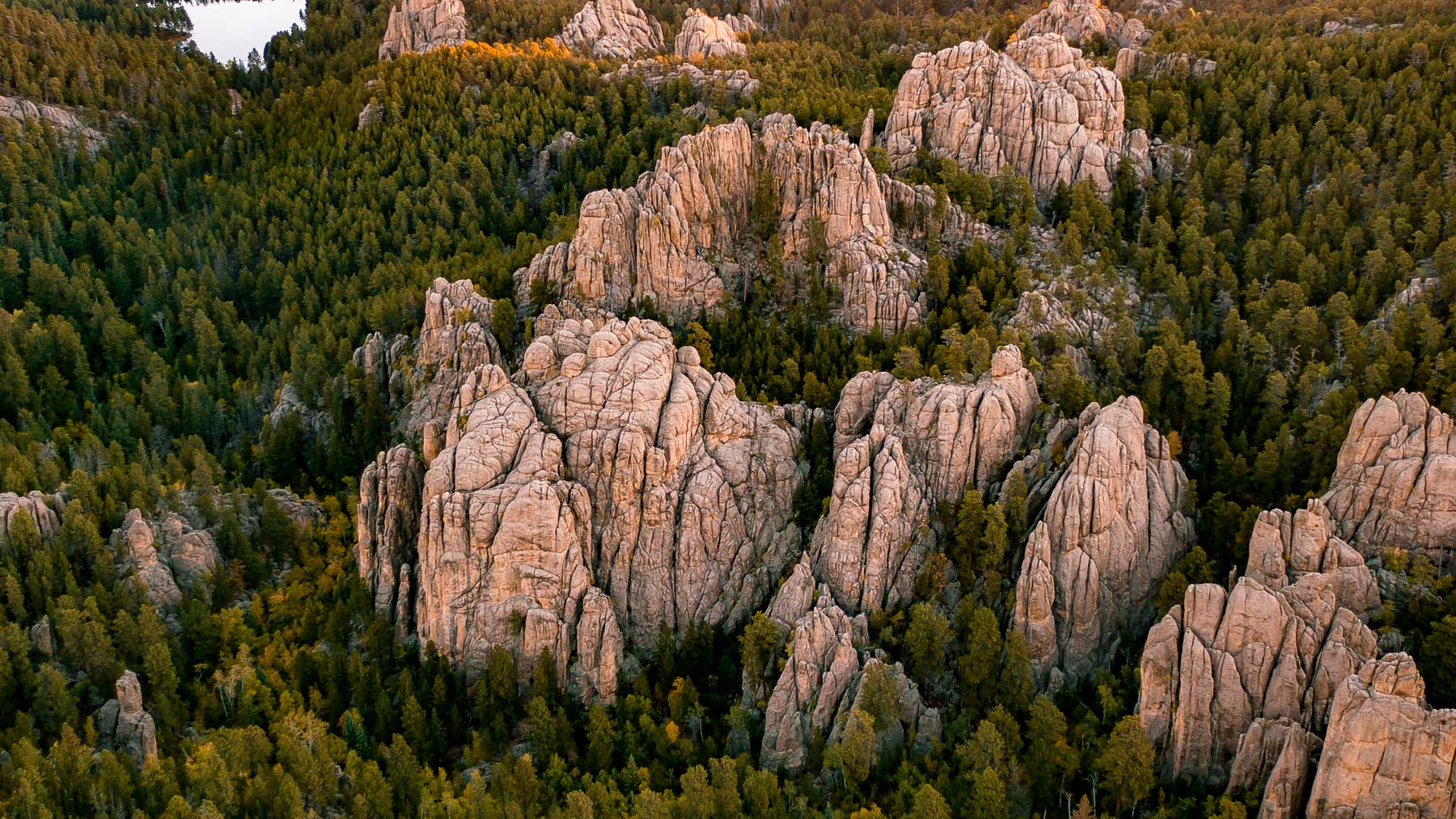
14. Interesting Mount Rushmore Facts
Here’s some interesting facts to know about Mount Rushmore prior to visiting.
Whose Faces Are on Mount Rushmore?
There are four presidents faces carved into the face of Mount Rushmore including (from left to right on the mountain face):
- George Washington
- Thomas Jefferson
- Theodore Roosevelt
- Abraham Lincoln
Who Chose the Faces on Mount Rushmore?
Contrary to popular belief, the faces on Mount Rushmore were not chosen by the US Government but rather the chief sculptor, Gutzon Borglum.
According to the national park service these presidents were chosen to be included on Mount Rushmore by Borglum because they represent the “founding, expansion, preservation, and unification” of America.
How Did Mount Rushmore Get It’s Name?
Mount Rushmore was named after a New York attorney, Charles E. Rushmore, who visited the Black Hills long before the carving project was thought of.
How Long Did it Take to Carve Mount Rushmore?

The carving of Mount Rushmore National Memorial took 14 years to complete from 1927 to 1941. The original plan called for carving each figure from the waist up but funding ran short and that plan was abandoned.
Who Carved the Faces on Mount Rushmore?
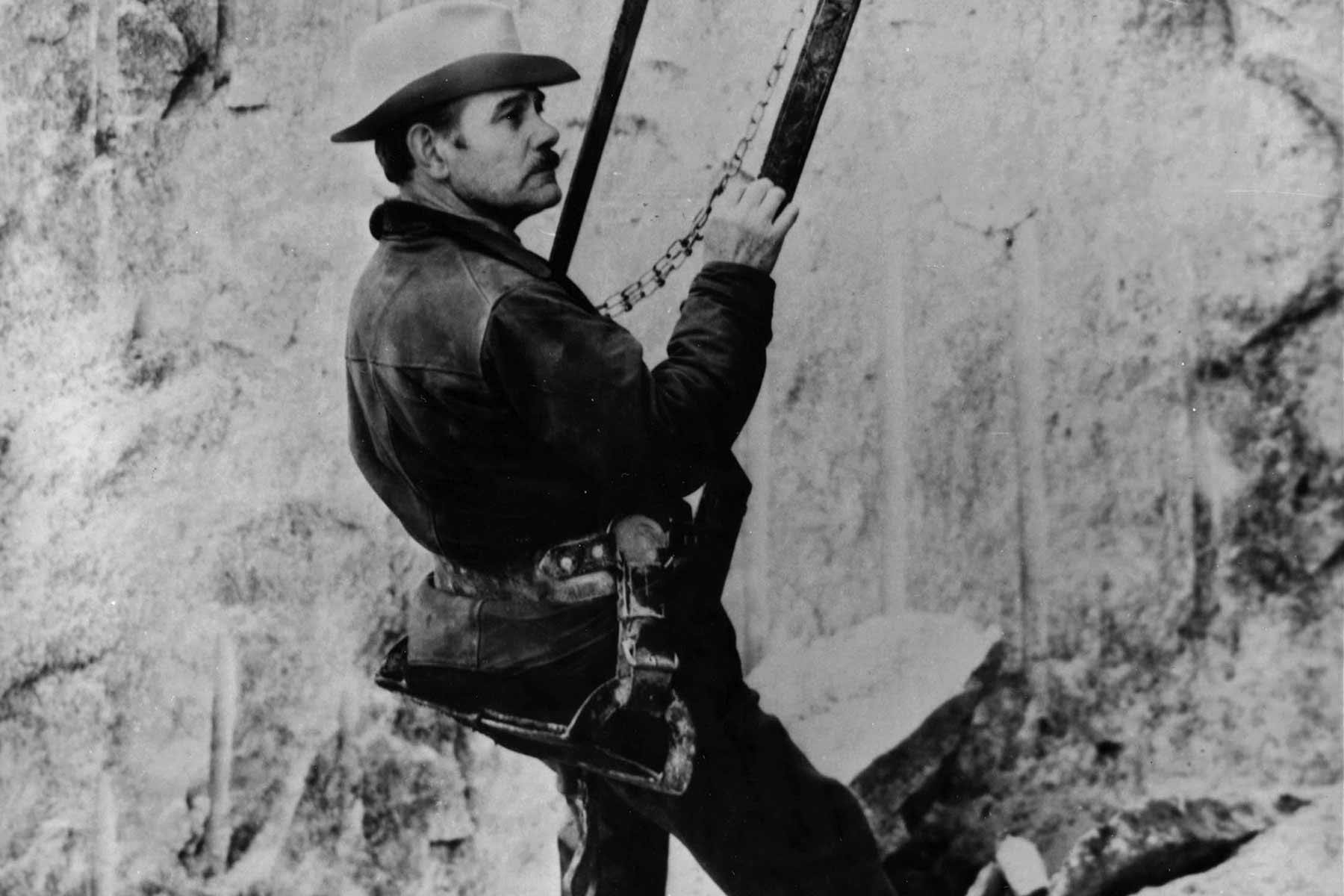
Gutzon Borglum was the creator of the sculptures and design for Mount Rushmore. He oversaw the project from start to months before its completion when he died. The role of leading the project was passed on to his son, Lincoln Borglum.
13. What is the Mount Rushmore Controversy?
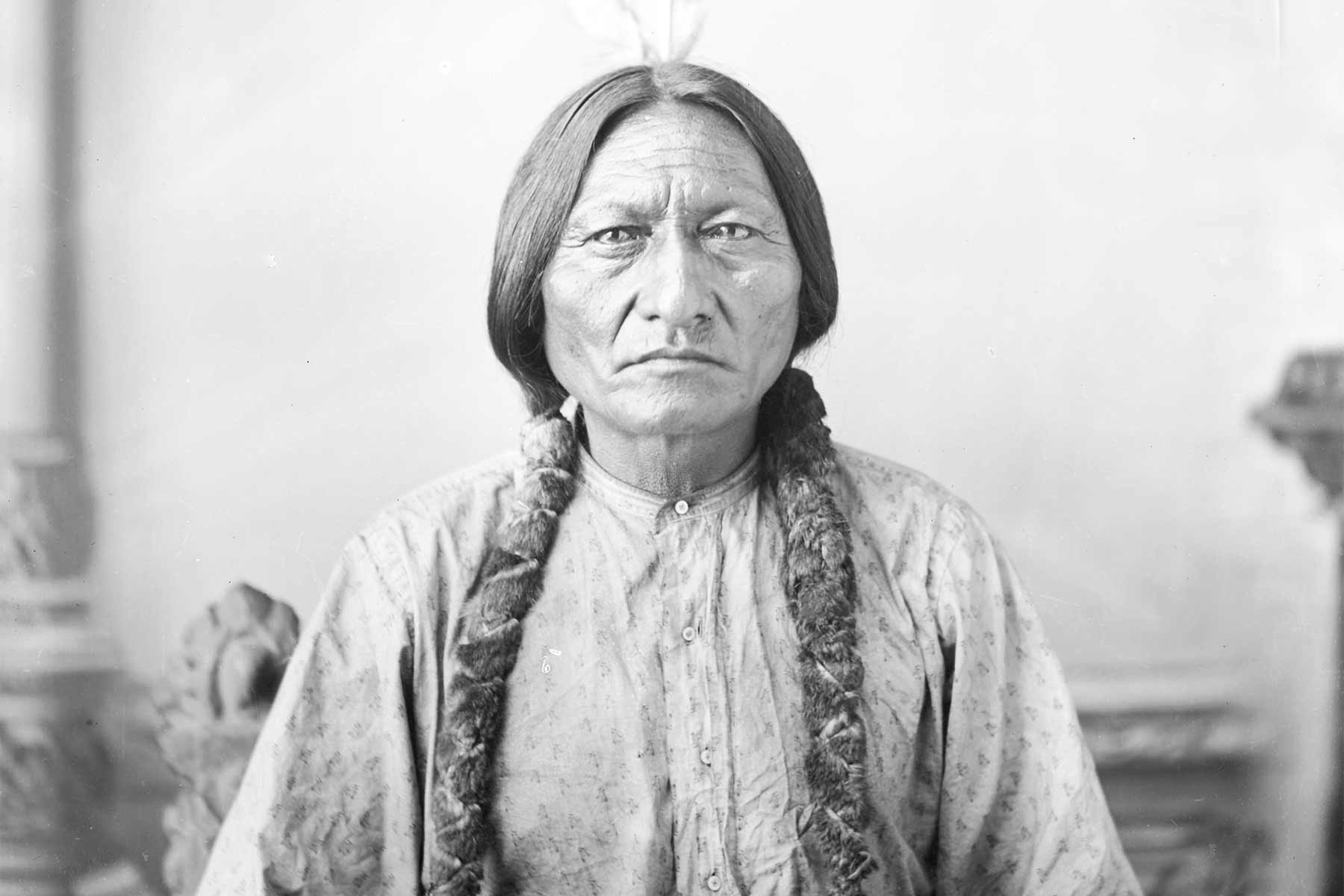
The controversy behind Mount Rushmore starts with the fact that the land that was chosen for the site is located in the heart of the Black Hills in South Dakota. This land is sacred to the Lakota Sioux who lived here long before Americans arrived on the scene.
A Little Mount Rushmore History (of the area)
After the Civil War, western expansion in the United States really picked up as did the governments cruel policies against the native peoples who lived in those lands.
Many of the generals who fought on both sides of the war went on to lead savage attacks against native tribes throughout the west, almost entirely extirpating these people from their lands.
As for the Black Hills, the US Government reached a settlement with the Lakota in which they were promised the Black Hills in perpetuity (known as the Treaty of 1868).
Perpetuity in the eyes of the government turned out to be a lot less perpetual than was originally agreed upon as gold was discovered in the Black Hills. In the 1870s the government forced the Sioux out of the region in favor of the gold hungry miners.
Crazy Horse, Sitting Bull, & Wounded Knee

Faced with terrible reservation conditions and the prospect of losing their ancestral lands forever, the native peoples decided to resist the US Government across the plains.
The efforts in the Black Hills were lead by Crazy Horse and Sitting Bull who fought against the federal troops. Their success peaked early at the Battle of the Little Bighorn where they defeated General George Armstrong Custer (a former Union cavalry commander).
This battle is also famously remembered today as Custer’s last stand.
Eventually the natives would go on to lose their war against the US Government with the last significant defeat taking place at Wounded Knee.
Despite commonly being referred to as a battle, the events at Wounded Knee were actually a horrific massacre carried out by the federal troops against innocent native women, children, and men. The massacre resulted in the deaths of nearly 300 natives.
The Heart of the Controversy
This leads us back to the controversy over the sculpting of Mount Rushmore. Less than 40 years after the Massacre at Wounded Knee, the faces of revered leaders of the same government that was responsible for the events were blasted and carved into the sacred Black Hills.
This was done despite early proposals calling for both native and US heroes of the west to be carved onto the mountain.
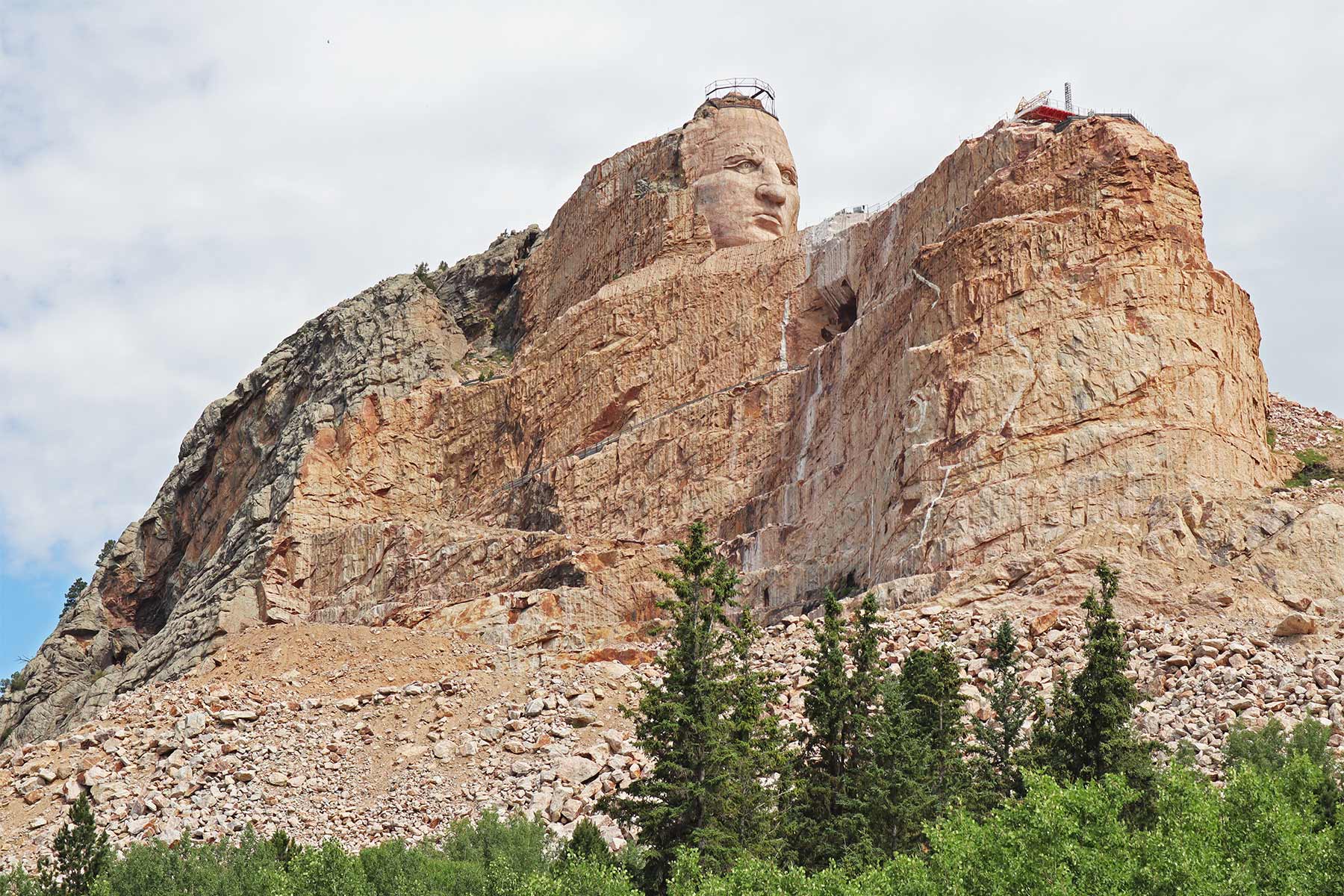
Today, the much larger Crazy Horse Memorial is being constructed just 17 miles down the road from Mount Rushmore as a response to the Rushmore project.
At present, many local native leaders would like the site returned to them and the focus of the park to be turned to the oppression of their people.
12. When is the Best Time of Year to Visit Mount Rushmore?
The best time of year to visit Mount Rushmore is in the Fall and Spring when temperatures are moderate and crowds are lesser.
I have visited the memorial in all seasons and personally, I recommend visiting Mount Rushmore in the fall when the foliage throughout the Black Hills is spectacular.
The best month to visit Mount Rushmore is October for peak fall foliage but May & September are also great.
Summer in Mount Rushmore brings massive crowds (especially for the 4th of July) and major heat (sometimes over 90 degrees).
If you’re trying to have the memorial all to yourself then Winter is a great time to visit Mount Rushmore. This is the least crowded season at Rushmore with freezing temps and regular snowfall.
If you’re interested in road trips around the area, check out our article: 15 BEST USA Road Trips of a Lifetime 2022 (+ Photos)
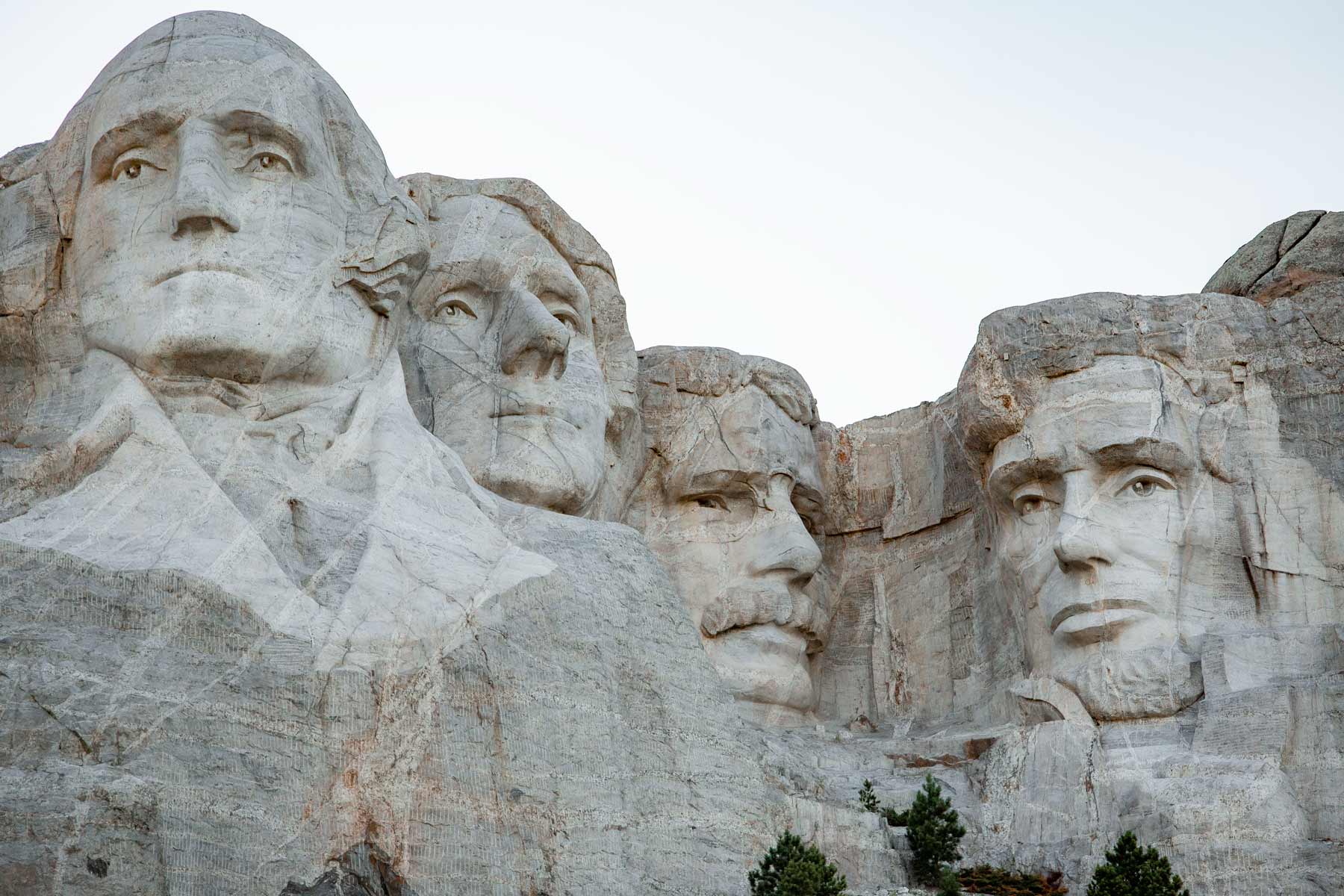
11. When is the Best Time of Day to Visit Mount Rushmore?
Mount Rushmore is open 365 days per year. On Christmas all of the buildings are closed but Rushmore is still open on Christmas Day!
Mount Rushmore Hours
- October 1, 2021 – March 12, 2022: 5am – 9pm
- March 13, 2022 – September 30, 2022: 5am – 11pm
- October 1, 2022 – March 11, 2023: 5am – 9pm
If you’re looking to avoid crowds then I recommend visiting Mt. Rushmore early in the morning (the earlier the better). The peak visitation time is around the lunch hour and middle of the day.
Around sunset the crowds begin to dwindle down again from their midday highs.
Evening is a great time to visit to see the Light Ceremony but make sure to book in advance.
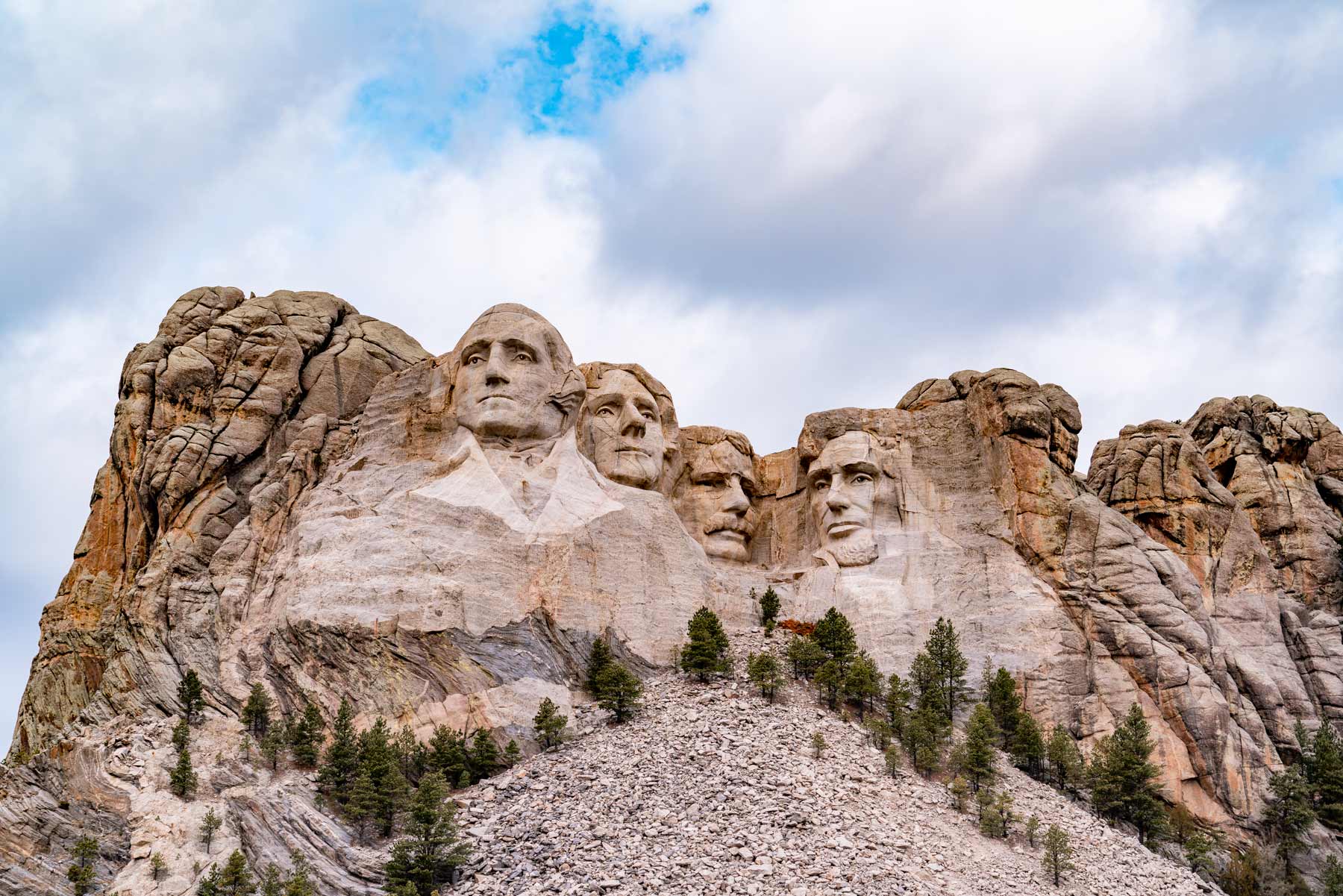
10. How Much Time to Spend at Mount Rushmore
If you’re just looking to check the box then the shortest possible visit at Mount Rushmore is about 45 minutes. This would include:
- Parking the car, walking down the Avenue of the Flags (where every state flag is displayed), blazing through the visitor center, soaking in the main view from the Grand Terrace.
With two hours, you can stroll the Avenue of Flags, spend some time admiring the view from the Grand View Terrace, watch the film in the visitor center about the epic construction of Mount Rushmore, and even grab yourself a monumental breakfast at the cafeteria.
In one day, you can do all of the above mentioned things plus hike the Blackberry Trail (1 mile each way) to escape the crowds and get into a more natural setting.
With one week, see more of the incredible sites around Mount Rushmore including two national parks, two national monuments, a national forest, state parks, and more. Scroll below for more on the surrounding attractions worth seeing.
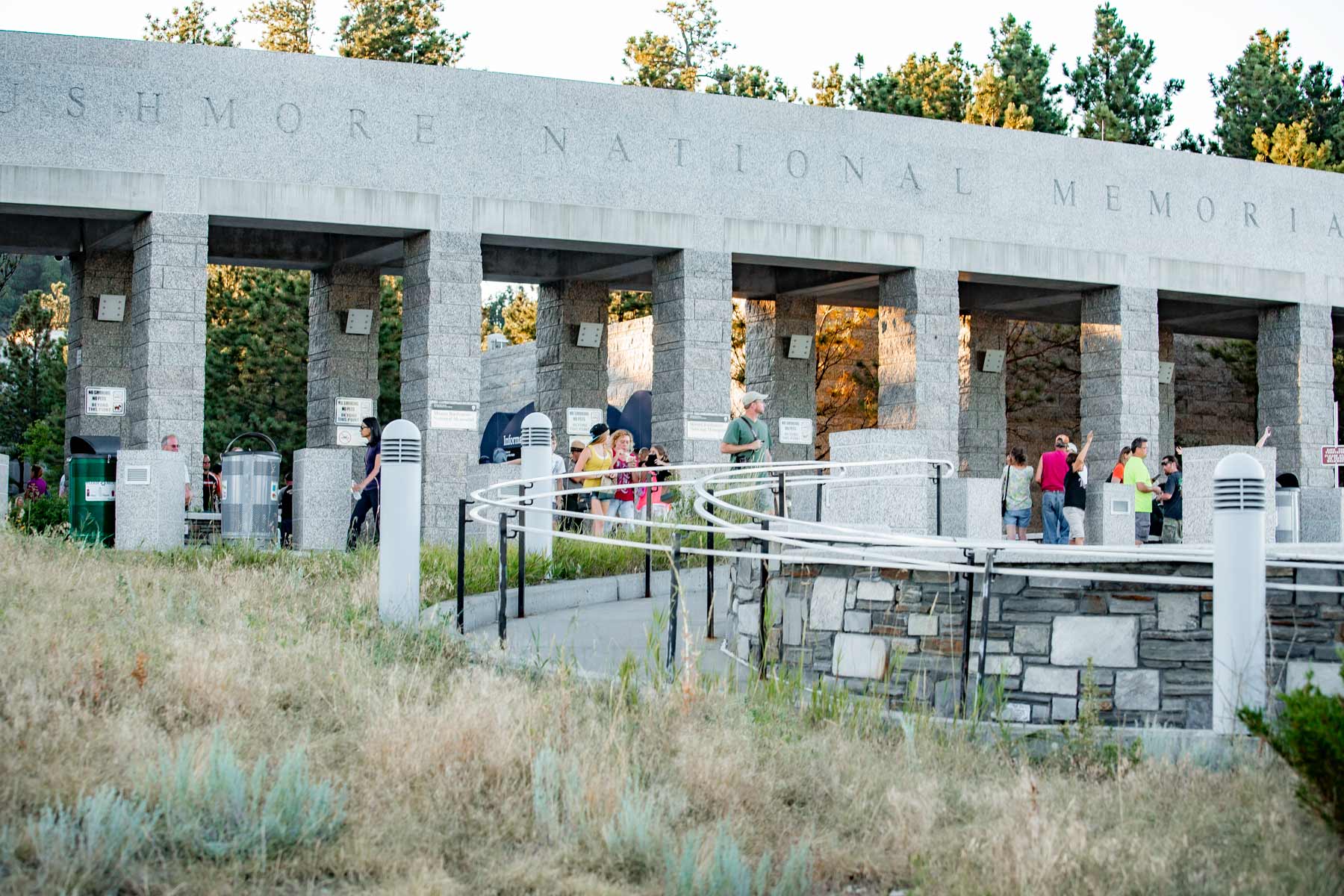
11. How Much Does It Cost to Visit Mount Rushmore?
We’ve got some good news here! Mount Rushmore National Memorial does not charge an entrance fee for visitors.
However, there is a parking fee which is $10 per vehicle which you must pay in order to park at Mount Rushmore.
Parking at Mount Rushmore
When you drive up to Mt. Rushmore, you’ll reach a ticket booth. Press the button to take the parking ticket and then park your car in the massive parking facility.
Keep your ticket to pay at one of the automated ticket machines located in the parking garages and at the Mt. Rushmore Entrance. To pay, simply insert your parking ticket into the parking machine then follow the prompts.
Cash and credit cards are accepted for the $10 fee. Once your ticket is returned to you from the machine take it with you. When exiting the garage simply insert the card back into the machine and up goes the gate.
NOTE: This parking permit is valid for an entire year from the purchase date. If you plan on returning to Mt. Rushmore within a year then hold onto it to use again.
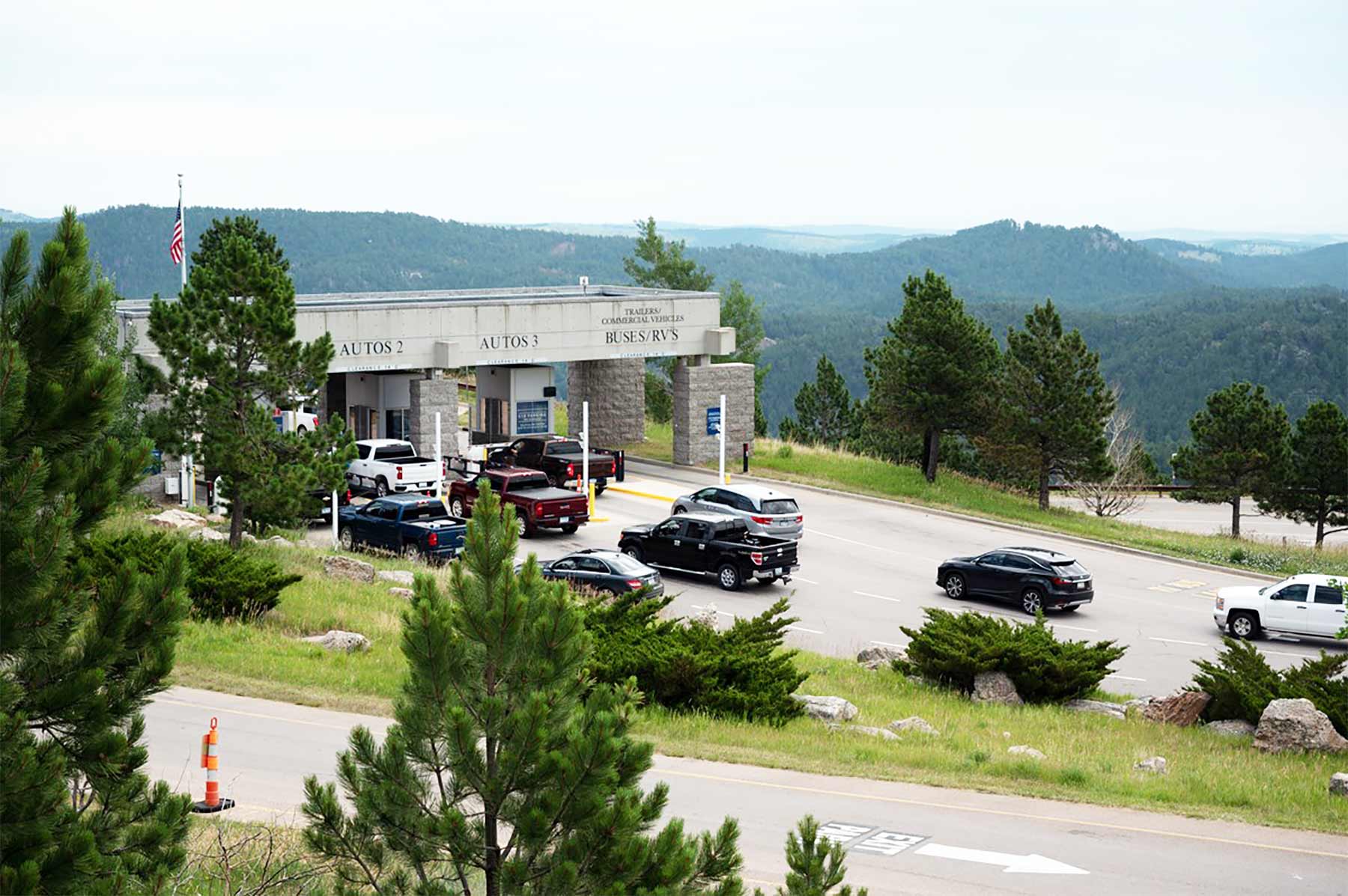
Things to Do At Mount Rushmore
10. Walk the Avenue of the Flags
After arriving at Mount Rushmore, parking your car, and approaching the memorial itself, visitors enter through a grand promenade known as the Avenue of the Flags.
I was struck by the beauty of this viewpoint more than any other in the memorial as having the most grandeur.
This short stroll frames the faces on the monument beautifully between the flags of every state in the US. How long will it take for you to find your state’s flag?
The Avenue of the Flags serves as the main walkway from the parking area to the Grand View Terrace.
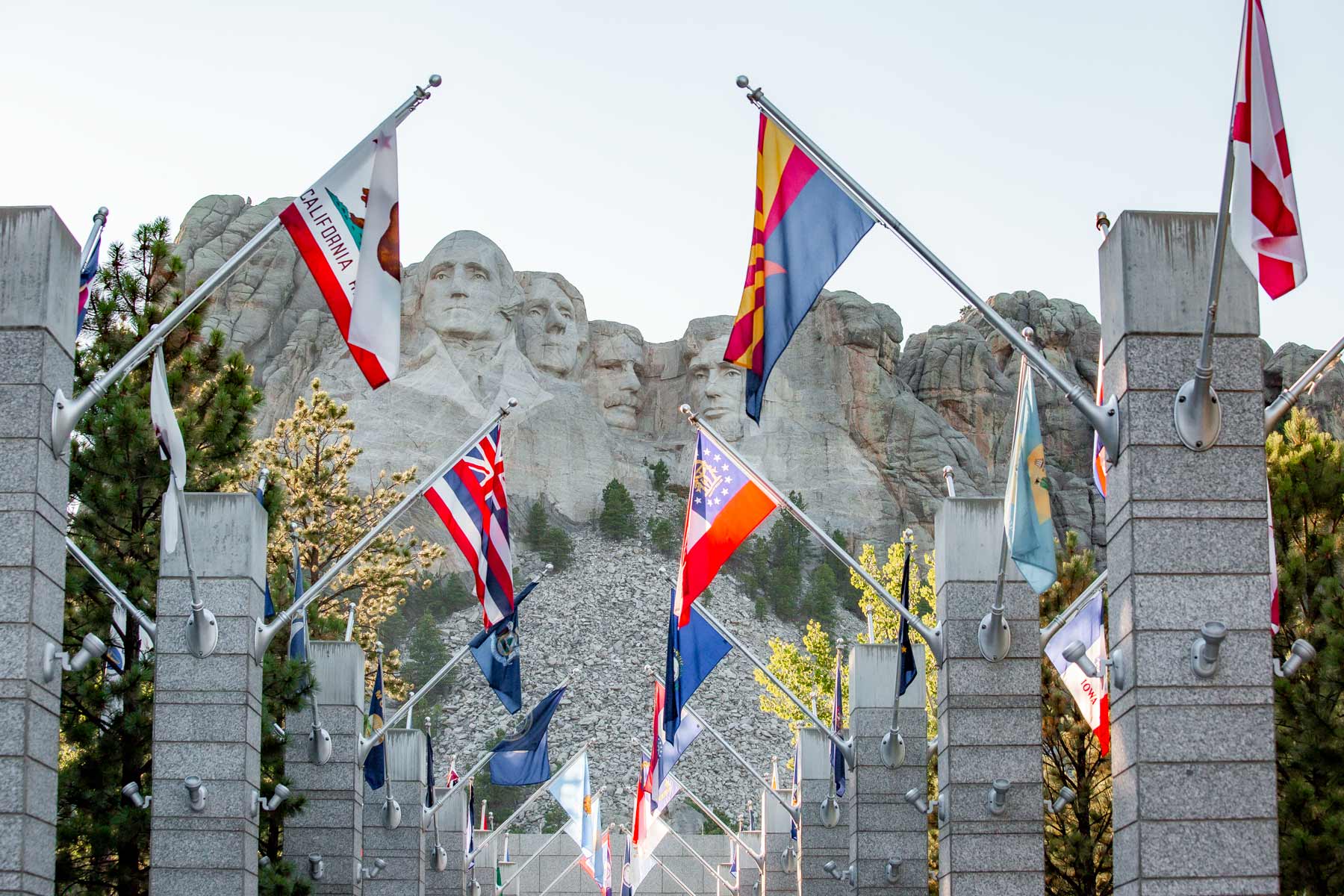
9. See the Faces from Grand View Terrace
The main viewpoint at Mount Rushmore and best place to see the president’s faces is from the Grand View Terrace. From this point you have clear, unobstructed views of the faces.
While impressed by the memorial itself I must admit I found the faces themselves to appear a bit smaller than I expected. Maybe it’s the Hollywood effect?
I am curious to know if you feel/felt the same way when visiting the grand view terrace – leave a comment below!
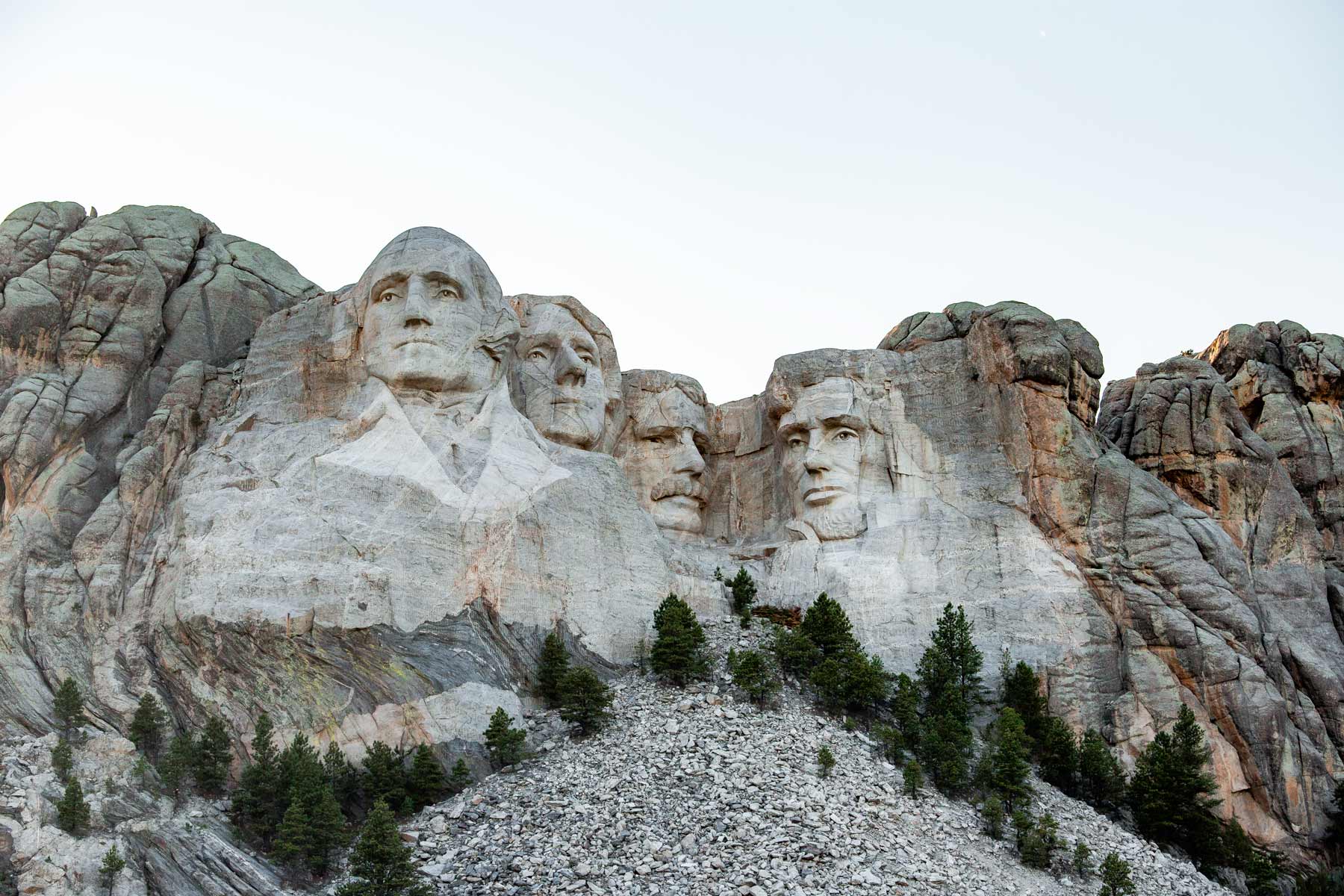
8. Hike the Presidential Trail
When visiting Mount Rushmore there are just two hikes in the memorial, the best of which is the Presidential Trail.
Most folks who visit the monument end their trip after seeing the Grand View Terrace but I recommend going further and hiking the Presidential Trail.
- Distance: 0.6 miles
- Elevation: 422 stairs
- Time Required: 30 minutes
- Skill Level: Easy
The Presidential Trail starts near the visitor center and takes you closer to the carved faces. At just .6 miles this trail is easy taking about 30 minutes to complete at a leisurely pace but does involve 422 stairs to climb.
I recommend hiking this trail in the clockwise direction so that you are looking up at the monument most of the time rather than back at the visitor center.
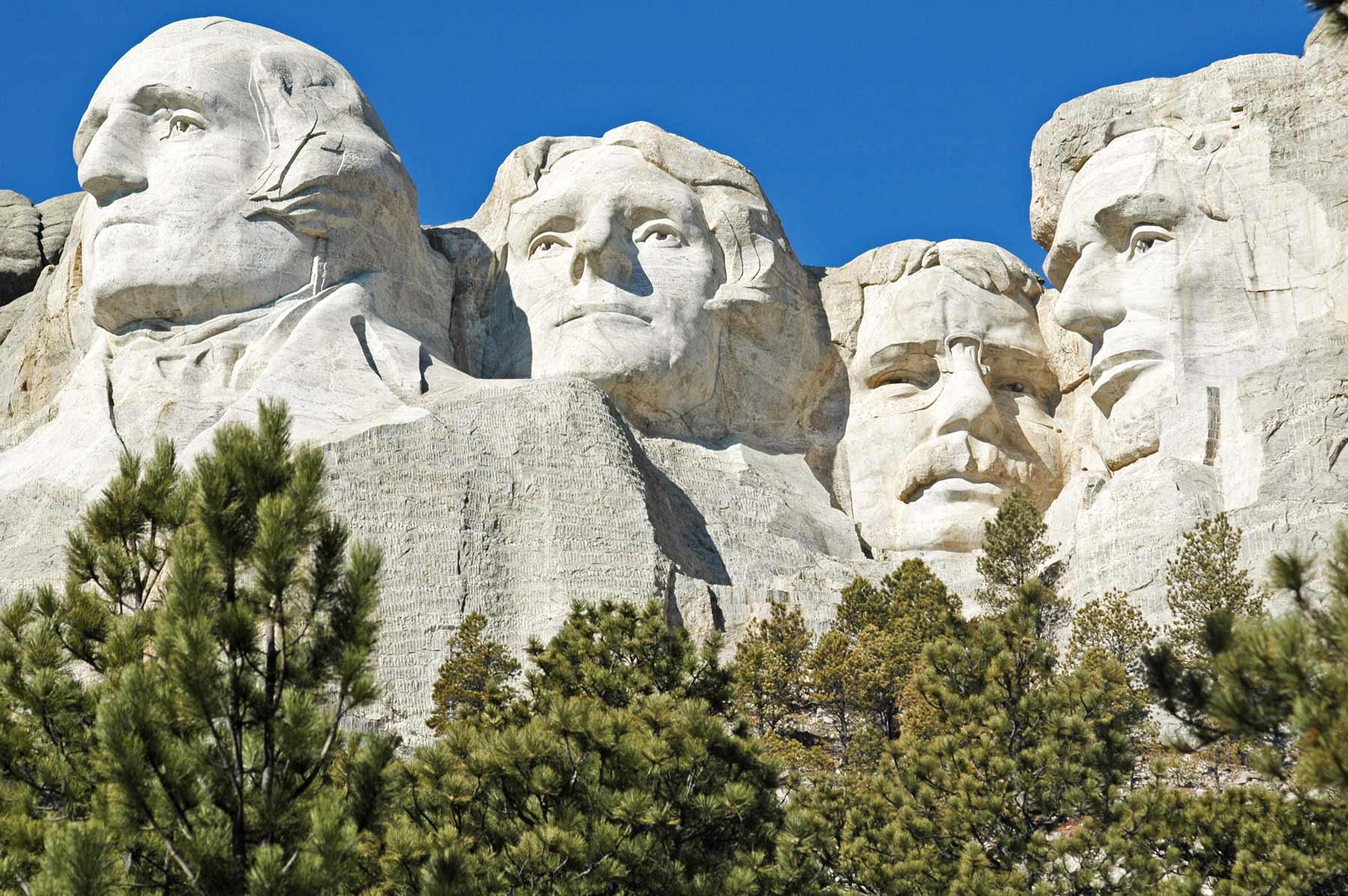
7. Have a Monumental Meal at Carver’s Cafe
One of my favorite memories from visiting Mount Rushmore was having the “monumental breakfast” at Carver’s Cafe with my dad and brother.
This is a great way to soak in the moment with good enough food and epic views of Mount Rushmore.
The offerings here are basic including things like pizza, french fries, chili, sausage, eggs, biscuits, and so on.
I remember eating here once and having the place to ourselves when there was snow on the faces and a marmot crawling around on a rock just outside the window.
The prices were about what you’d expect for a place like this that can charge for the view. I believe we paid about $50 after tax for 3 people. This included monumental breakfasts for each of us + coffee.
6. Visit the Sculptor’s Studio
Located at the end of the Presidential Trail, the Sculptor’s Studio is a great spot to enrich your visit. The studio is a small building where Gutzon Borglum worked for two years while sculpting Mount Rushmore.
Operating Seasons:
- Open Daily Late May – October 1
Today you can see the scale model of the original concept for Mount Rushmore including the presidents from the waist up. This larger concept was abandoned due to the project running out of funds.
There are also daily ranger talks held here (on a seasonal basis) which are really great to gain a better appreciation for the memorial.
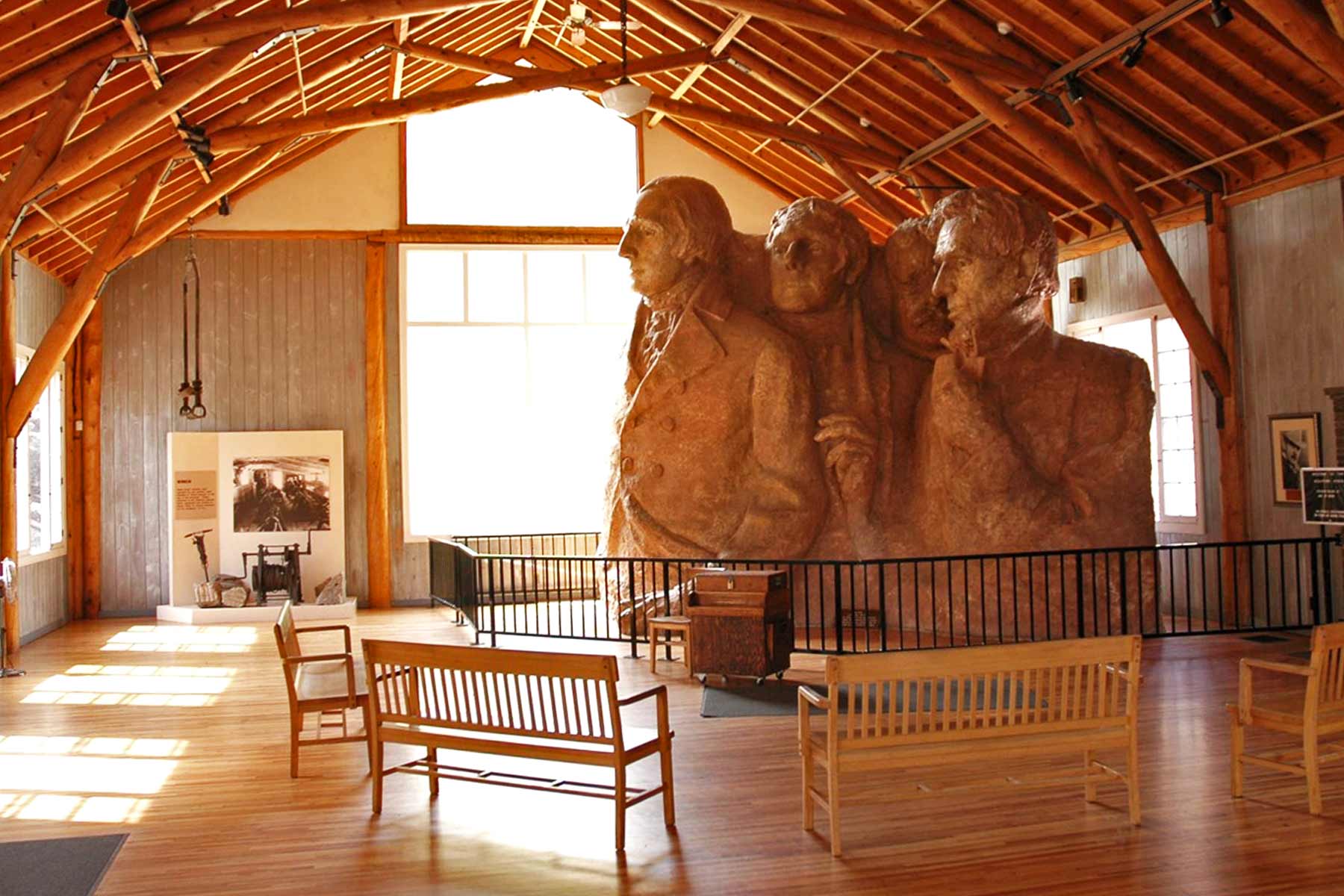
5. See the Lincoln Borglum Visitor Center
There is no better place to learn about the history and undertaking of Mount Rushmore than the Lincoln Borglum Visitor Center.
Manged by the National Park Service, this visitor center is a trove of photos and information that help one to gain a better understanding of the memorial.
Loaded with archival images, historical artifacts, and even a bookstore this is a great addition to your Mount Rushmore trip.
I highly recommend watching the free 15 minute film that can be viewed in the visitor center.

4. Treat Yourself to Some TJ’s Ice Cream
Who’s this TJ and what’s all the craze about their ice cream? Why it’s Thomas Jefferson, of course and this is his ice cream recipe!
According to the park concessionaire who manages the ice cream stand, “this extraordinarily rich ice cream gets its sweet vanilla flavor from vanilla beans sourced from where Mr. Jefferson would have gotten them in his day.”
The concessionaire also claims “President Jefferson has been given credit for having the first written recipe for ice cream to the United States.”
Whether or not any of that is actually true, the ice cream is delicious, especially on a hot summer day.
3. Extend Your Visit by Hiking the Blackberry Trail
The Blackberry Trail is one of only two trails located within Mount Rushmore Memorial. It was designated as a National Recreation Trail in 2018 that connects with the Centennial Trail in the Black Elk Wilderness.
- Distance: 2 miles (round trip)
- Elevation: Minimal
- Time Required: 45 – 60 minutes
- Skill Level: Easy
The trail is a great way to escape the crowds and connect with the natural scenery of the Black Hills. Hikers are guaranteed to see and hear the countless birds of the region.
At just one mile each way with minimal elevation gain, the Blackberry Trail is an easy jaunt to stretch the legs.
2. Watch the Sunset Across the Memorial
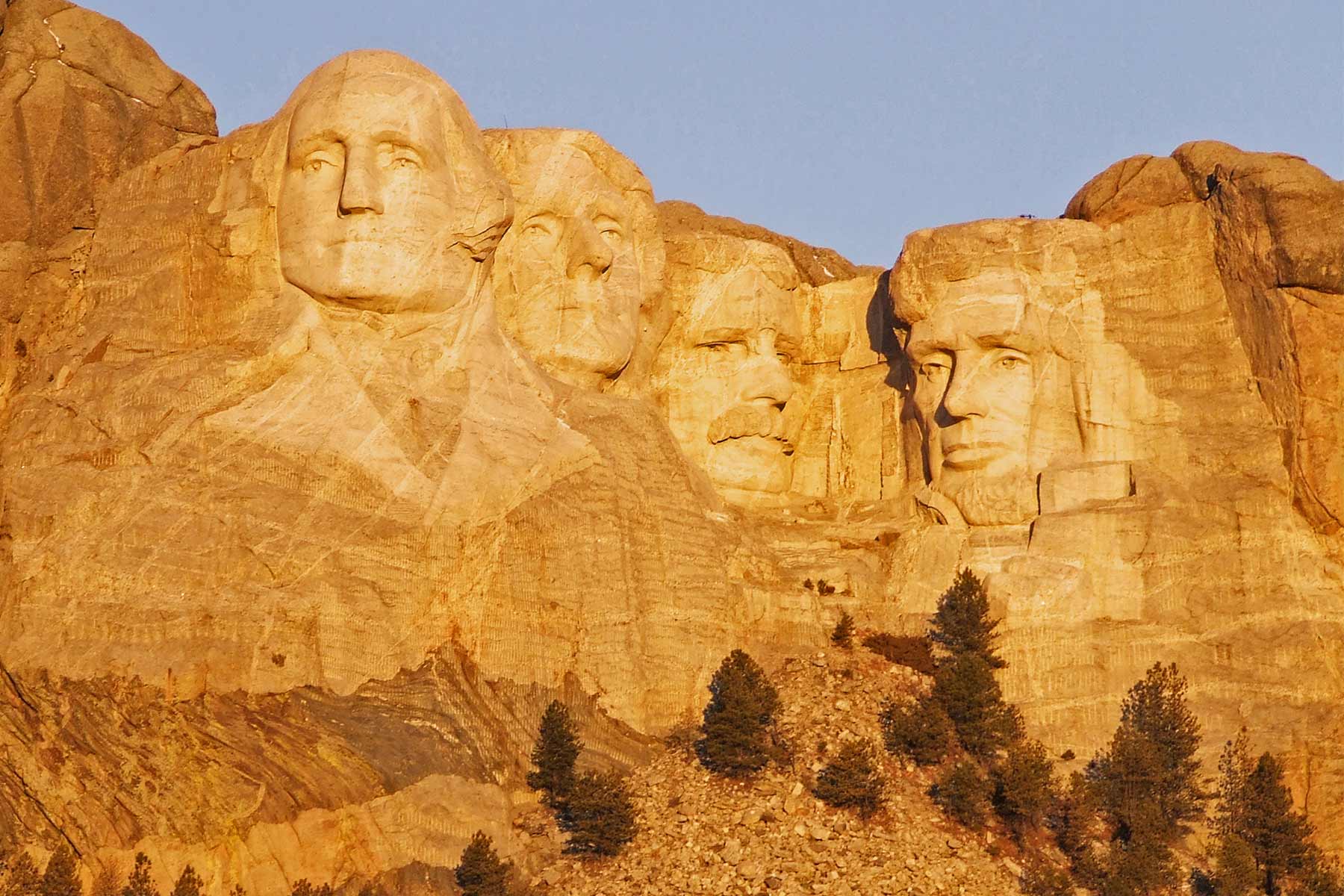
One of the most magical times to see Mount Rushmore is at sunset as the crowds begin to die down and the mountain changes colors from grey to sunset hues.
If you have the time this is a great time to take a seat at the Grand View Terrace or in Carver’s Cafe and reflect on the majesty of the memorial.
Be sure to check ahead of time to see what time sunset is at Mount Rushmore if you’re interested in seeing this display.
1. Stay for the Evening Lighting Ceremony
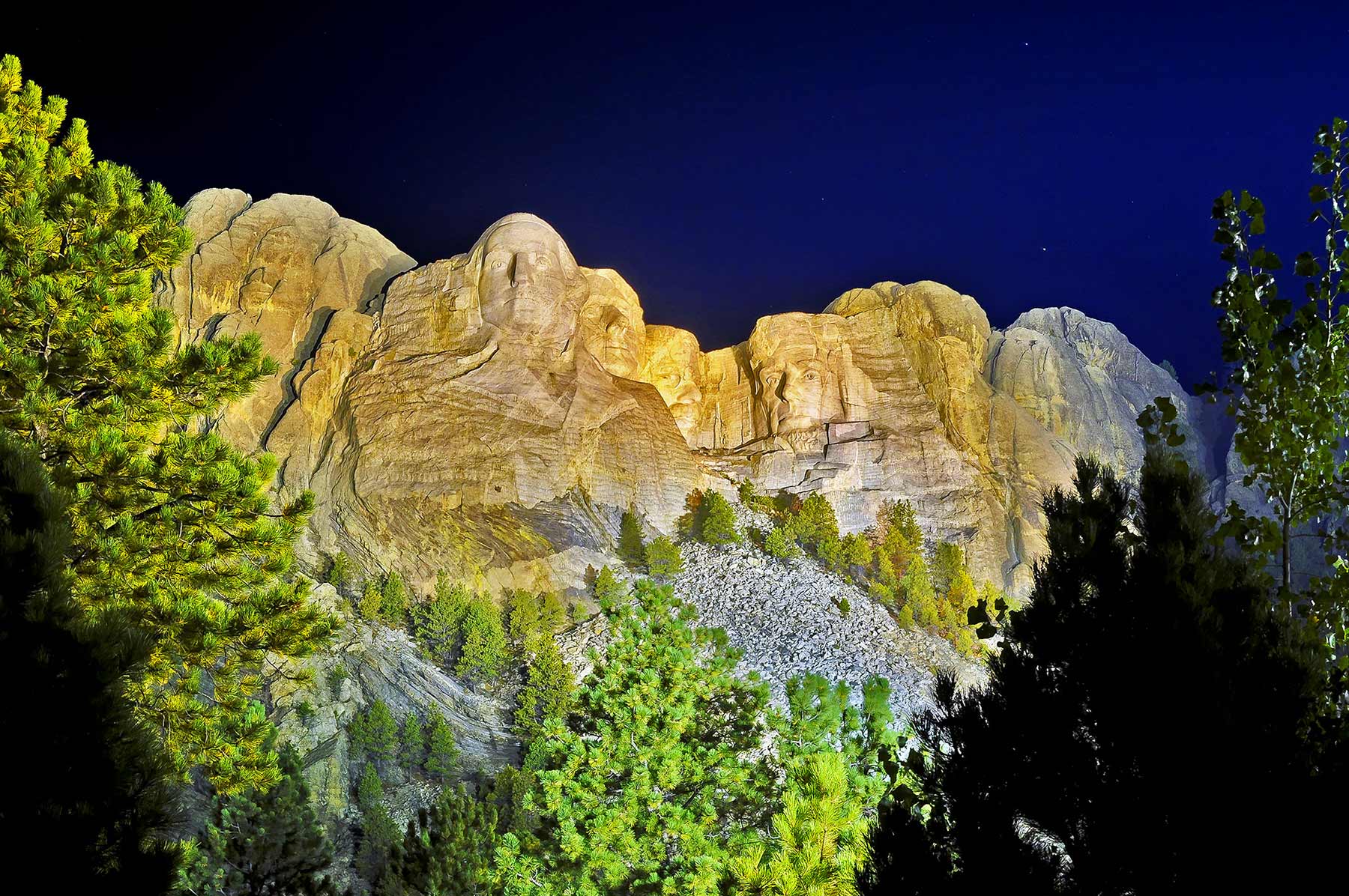
If you’ve watched the sunset at Rushmore you might as well stay for the evening lighting ceremony. At 45 minutes in length the ceremony starts at 9pm from late May to mid August and then 8pm from mid August to October 1.
Visitors can watch as the lights slowly begin to illuminate the faces of the presidents as night turns to day. Photos of the memorial at night take on a whole new feeling.
NOTE: This ceremony is seasonal running from late May to October 1.
Map of Mount Rushmore National Memorial
9 Epic Things to Do Near Mount Rushmore
Mount Rushmore is located in the heart of the Black Hills which are full of really incredible sites including two national parks, two national monuments, a national forest, state parks, and more.
For a more extensive list, check out our article on things to do near Mount Rushmore.
1. The Black Hills National Forest (borders Mount Rushmore)
Distance from Mount Rushmore: 0 minutes (it touches the memorial)
If you’re visiting Mount Rushmore, you’re also visiting the Black Hills National Forest – why not go a little further?
Mount Rushmore National Memorial is surrounded by the Black Hills National Forest. To get to the memorial you have to (get to) drive through this beautiful forest.
Of all the magical natural places I’ve traveled to in America (and beyond), the Black Hills National Forest might just top the list.
Maybe it’s just the dazzling rock formations, beautiful pine forests, incredible wildlife, mesmerizing magic hour, and insane amount of recreation opportunities that exist here.
There’s something almost spiritual about this place (just ask the native tribes who’ve lived here for nearly 10,000 years). Sure the air is crisp, the forests are vibrant, and the land is serene, but there’s something intangible about the Black Hills that you just have to experience for yourself.
Things to Do in the Black Hills National Forest
Hike To the Highest Point In South Dakota, Black Elk Peak – Black Elk Peak (formerly Harney Peak) is the highest point in all of South Dakota at 7,244 feet elevation. Hiking to the top is a wonderful way to see the best views in the Black Hills.
See the Stunning Spearfish Falls – Spearfish Falls is an 80 foot waterfall located on the Spearfish Creek that is often overlooked by folks as signage is lacking and the falls are not visible from the main road.
Drive the Incredibly Scenic Highway 16 Through the Black Hills – Highway 16 is an incredibly scenic drive that winds through the heart of the Black Hills National Forest. Several tunnels perfectly frame Mount Rushmore in the distance (by design). This is a lovely area to escape the Rushmore crowds and soak in the full beauty of the forest.
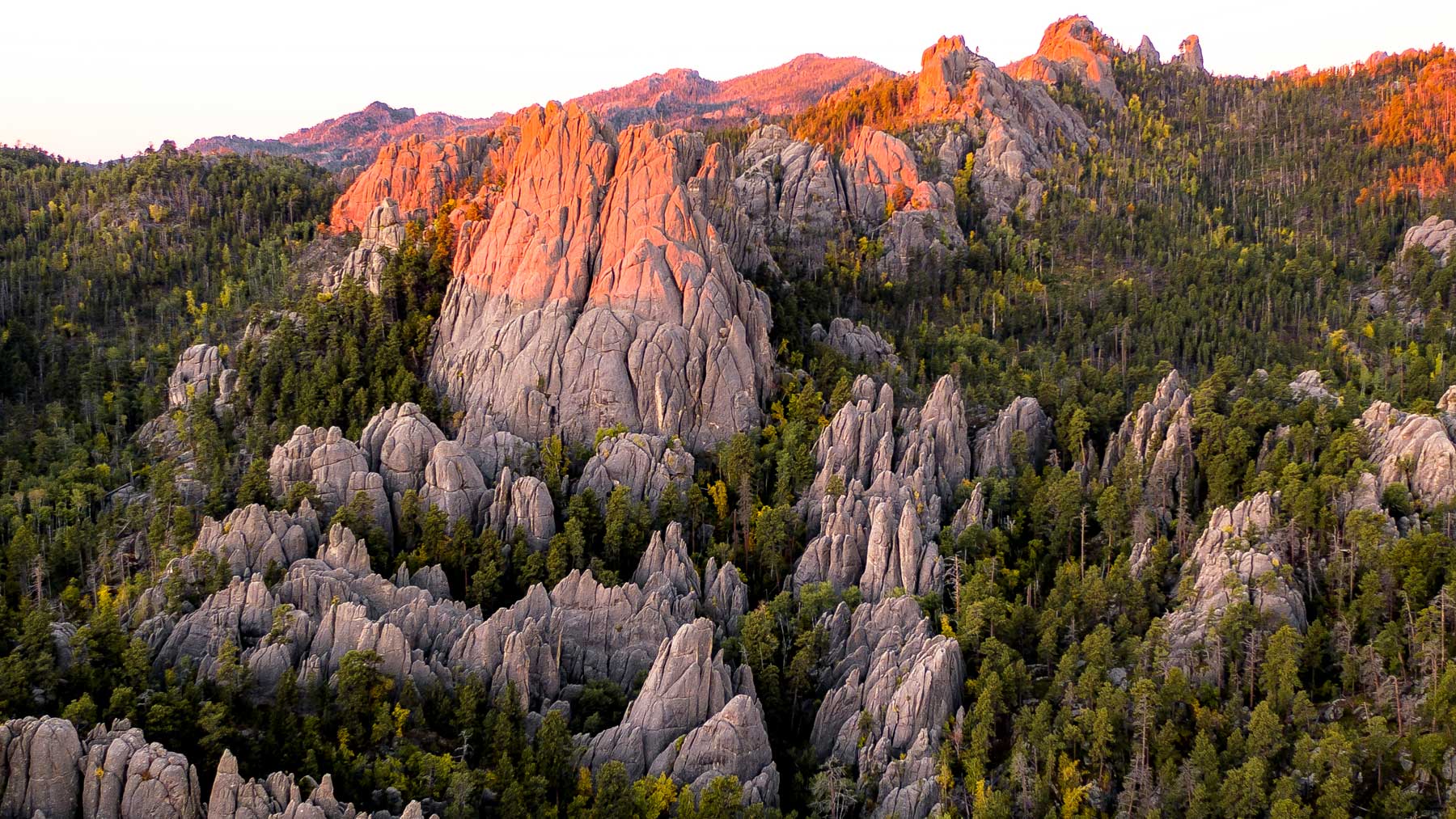
For more on the Black Hills check out our article: BLACK HILLS National Forest: An Epic Guide to South Dakota’s Crown Jewel
2. Wind Cave National Park (50 minutes from Mount Rushmore)
Distance from Mount Rushmore: 50 minutes (38 miles)
Wind Cave National Park is a world-class destination home to not only what could be the longest cave in the world but also beautiful natural scenery.
Here you’ll discover a land where the Black Hills meet the plains complete with bison, elk, pronghorn antelope, and prairie dogs.
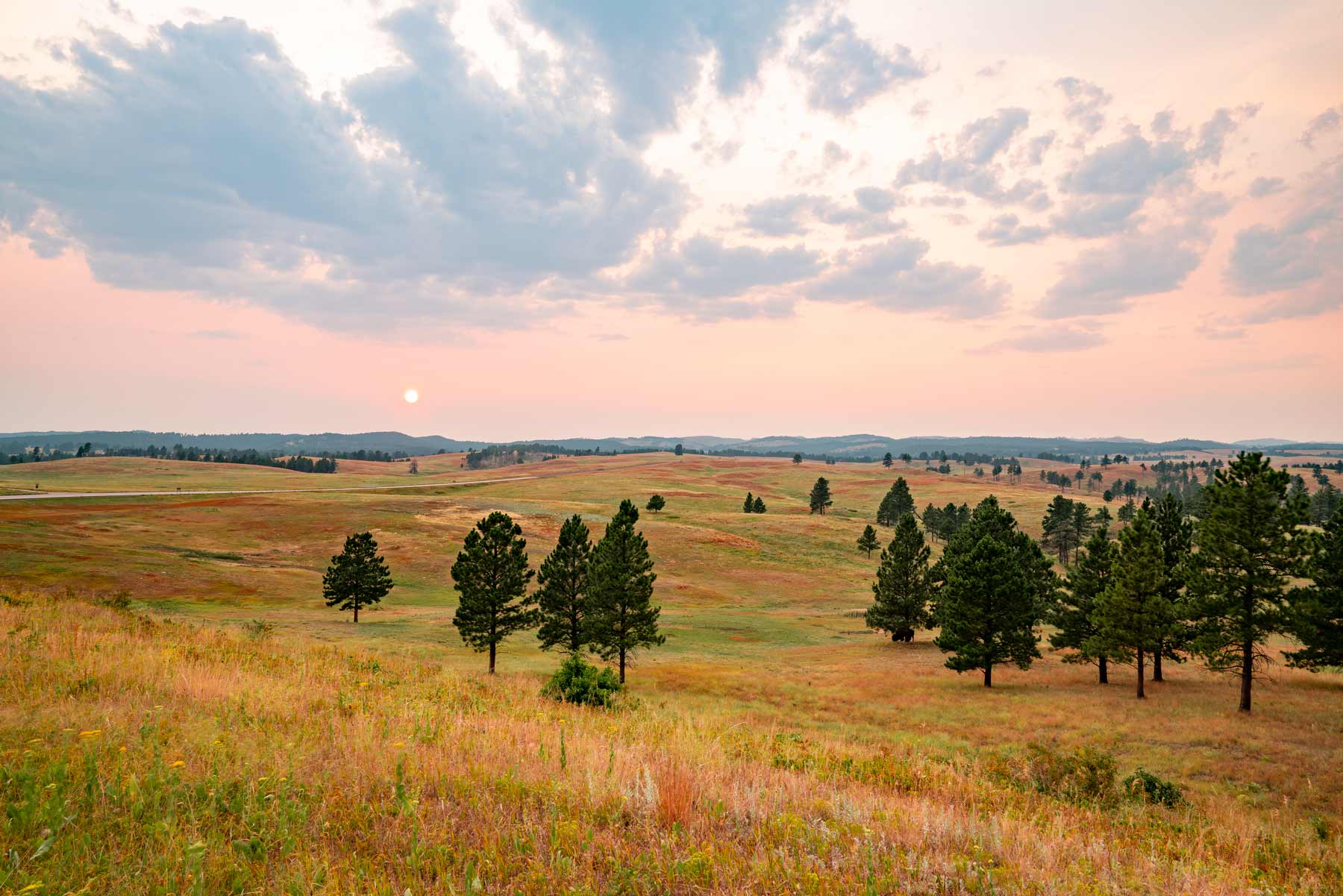
Planning a trip to Wind Cave? Check out our article: 10 Epic Things to Do at Wind Cave National Park
3. Badlands National Park
Distance from Mount Rushmore: 85 minutes (75 miles)
It’s a great idea to couple a visit to Mount Rushmore with one to Badlands National Park (less than 90 minutes away).
Situated in the heart of the Northern Great Plains, Badlands National Park spans 244,000 acres of spectacular landscapes, diverse wildlife, and the largest undisturbed mixed grass prairie in the United States.
Here you’ll discover a land where bison still roam and towers rise from the prairie in dazzling formations.
This vast unending prairie is draped in a beautiful silence where the only sounds to be heard are the uninterrupted winds of the prairie and the song of the western meadowlark.
Things to Do in the Badlands
Take it all in at Big Badlands Overlook – This overlook provides the quintessential view of what makes the Badlands the Badlands. Here you’ll find a panoramic view of perfectly striped red and white hills extending into the distance. This is a great spot for sunrise.
Go on an unexpected hike at Cliff Shelf Nature Trail – An oasis of juniper trees in the middle of the Badlands. Cliff Shelf Nature Trail is a spectacular spot to watch the sunset from a high vantage. You can also get out of the sun and cool off under the shade of old juniper trees
For more on the Badlands check out our article: 18+ (INCREDIBLE) Things to Do in Badlands National Park
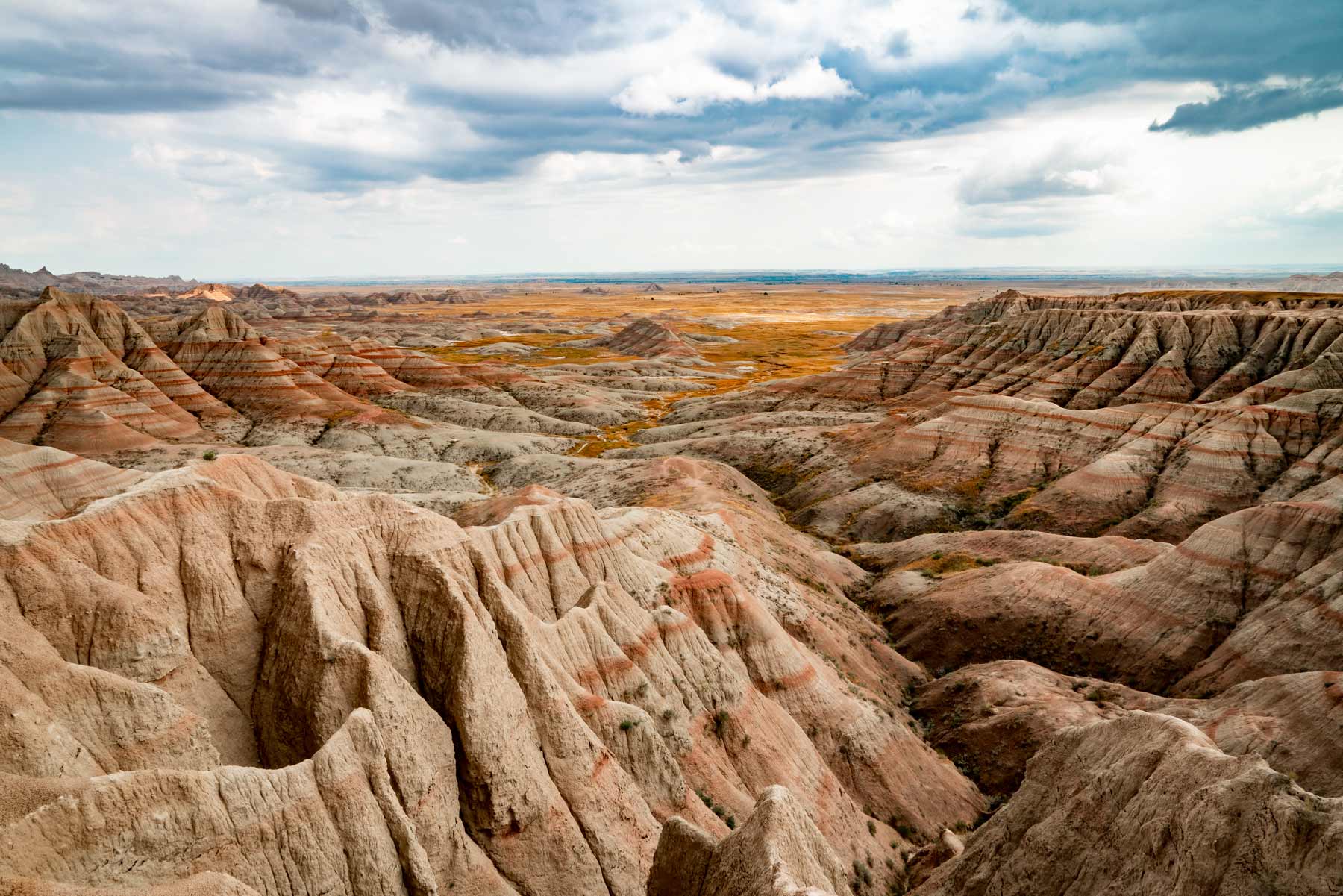
4. Wall Drug (80 minutes from Mount Rushmore)
Distance from Mount Rushmore: 80 minutes (77 miles)
If you don’t already know about Wall Drug you will when visiting the Badlands. Wall Drug is quite possibly the most famous roadside attraction in the world, a true slice of Americana as they say.
With billboards for hundreds of miles advertising their curious attractions and their 5 cent coffee and free ice water you simply have to go.
It also helps that Wall Drug is conveniently located in the town of Wall, SD, the gateway to Badlands National Park.
Here you can shop for souvenirs, grab a bit to eat, or just walk around and see what was so important that it needed to be cleverly advertised for hundreds of miles.

5. Devils Tower National Monument (2 hours from Mount Rushmore)
Distance from Mount Rushmore: 2 hours 13 minutes (130 miles)
Devils Tower National Monument is actually America’s first national monument thanks to Theodore Roosevelt invoking his newly acquired powers under the 1906 Antiquities Act.
Devils Tower is a classic national monument that checks all the boxes road trippers and public lands enthusiasts are looking for in an outdoor destination.
Of course I’d be remiss not to mention the 1977 sci-fi classic Close Encounters of the Third Kind, which of course was set here.
Having grown up on Steven Spielberg films it was a real treat for my brothers and I to visit Devils Tower and walk the loop trail around the tower searching for old filming locations and taking in incredible views.
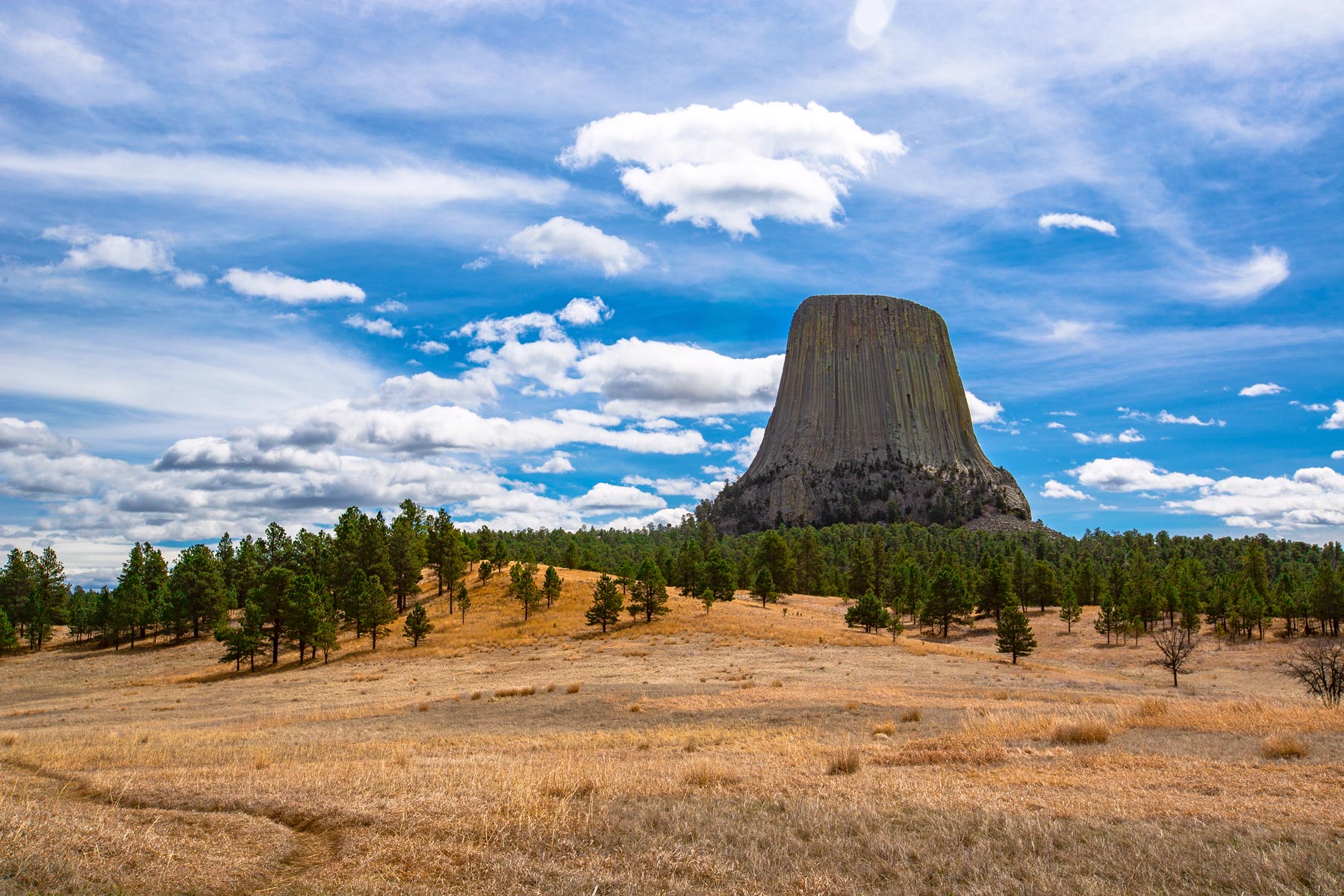
6. Crazy Horse Memorial
The Crazy Horse Memorial is currently being constructed just 17 miles down the road from Mount Rushmore as a response to the Rushmore project. Visitors can tour the grounds, learn about the native history, and walk up to the memorial itself.

7. Buffalo Gap National Grasslands (1 hour from Mount Rushmore)
Distance from Mount Rushmore: 1 hour (42 miles)
If you’re really looking to escape the crowds there’s no better place to do so than Buffalo Gap National Grasslands.
Consisting of 600,000 acres of beautiful rolling prairie, badlands formations, and home of the the world-famous Fairburn agate, this is a great thing to do near Mount Rushmore.
Check out the French Creek Campground area where you’ll find prime agate beds for rock hounding.
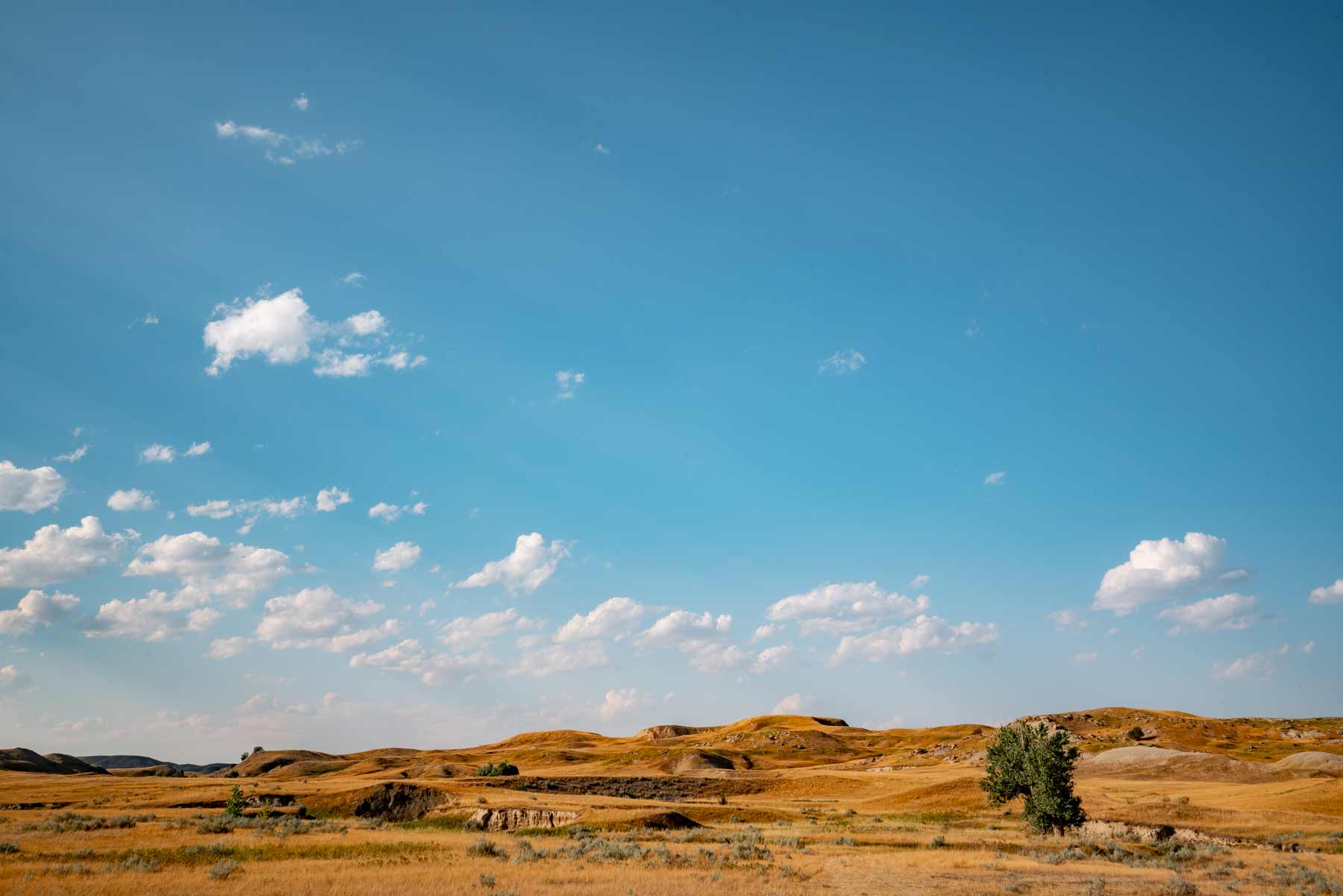
8. Custer State Park
Distance from Mount Rushmore: 44 minutes (20 miles)
Custer State Park is one of the largest areas of public lands located in the Black Hills and is one of the best things to do near Mount Rushmore.
I recommend a visit to Sylvan Lake and driving the Needles Highway.

9. Peter Norbeck National Scenic Byway (5 miles from Mount Rushmore)
Distance from Mount Rushmore: 10 minutes (5 miles)
- Location: South Dakota, USA
- Distance: 70 miles (112 km)
- Suggested Time: 3 days
- Minimum Time: 1 day
- Best Time of Year: June & October
The Black Hills of South Dakota are one of the most magical places in all of America and no road does a better job of displaying them in all their glory than the Peter Norbeck Scenic Byway. This is truly one of the great All-American Road Trips.
I recommend taking your time, driving slow, stopping at all the viewpoints, and enjoying the incredible scenic beauty.
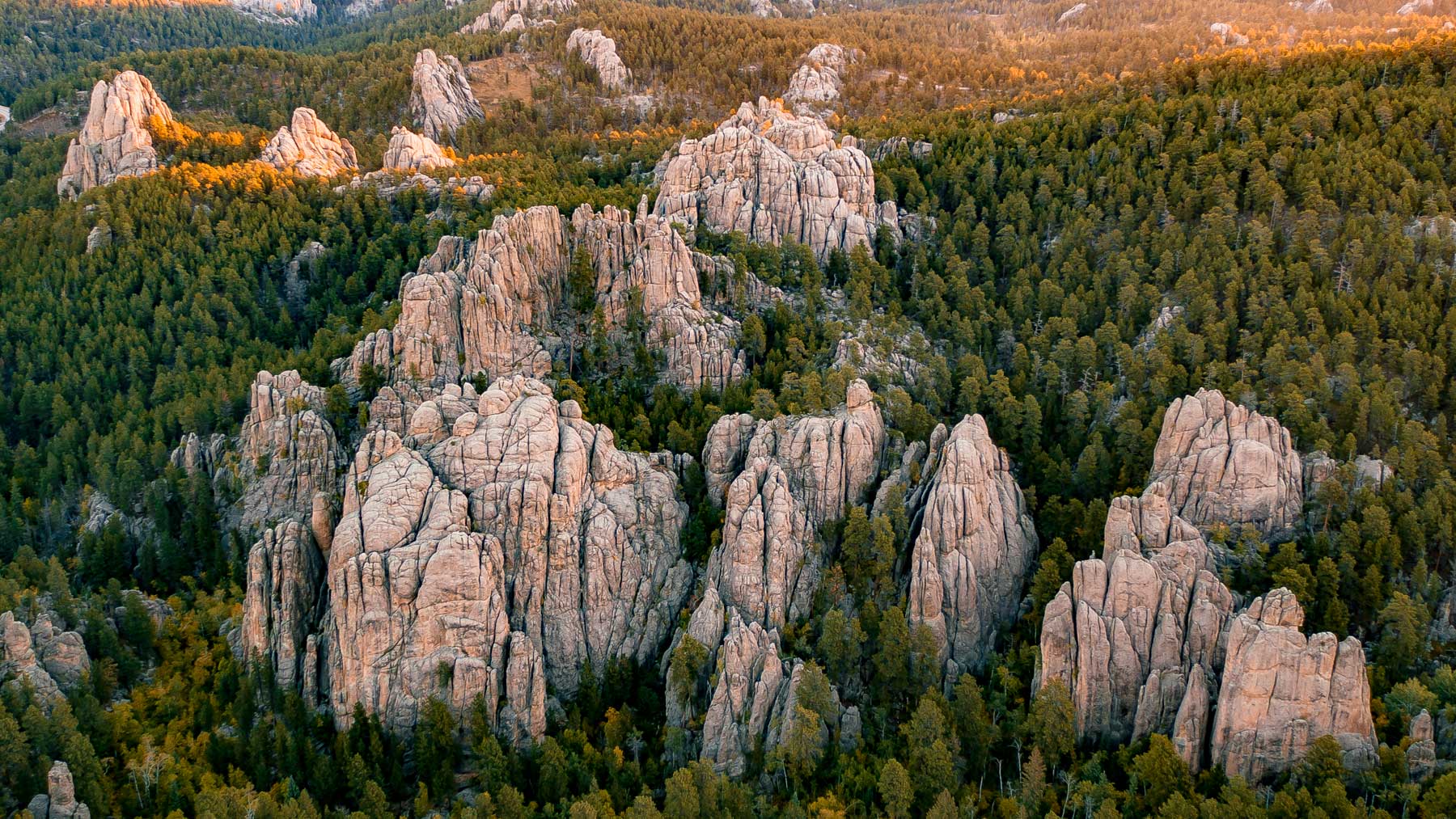
If you like scenic byways then check out our article: 15 BEST USA Road Trips of a Lifetime (+ Photos)
If you’re enjoying this article, you’ll love these:
- 18+ (INCREDIBLE) Things to Do in Badlands National Park
- A (Very) Helpful Guide to BADLANDS NATIONAL PARK (Photos + Video)
- BLACK HILLS National Forest: Epic Guide to South Dakota’s Crown Jewel
- 6 EPIC South Dakota National Parks Worth Visiting (+ Photos)
Why Listen to Us About Visiting Mount Rushmore?
You should probably know that we don’t just make this stuff up out of thin air. We’ve spent our entire adult lives exploring and filming America’s national parks and public lands.
We’ve worked with the National Park Service, the Department of Interior, and the U.S. Forest Service for years creating films on important places and issues.
Our work has been featured in leading publications all over the world and even some people outside of our immediate family call us national parks experts.
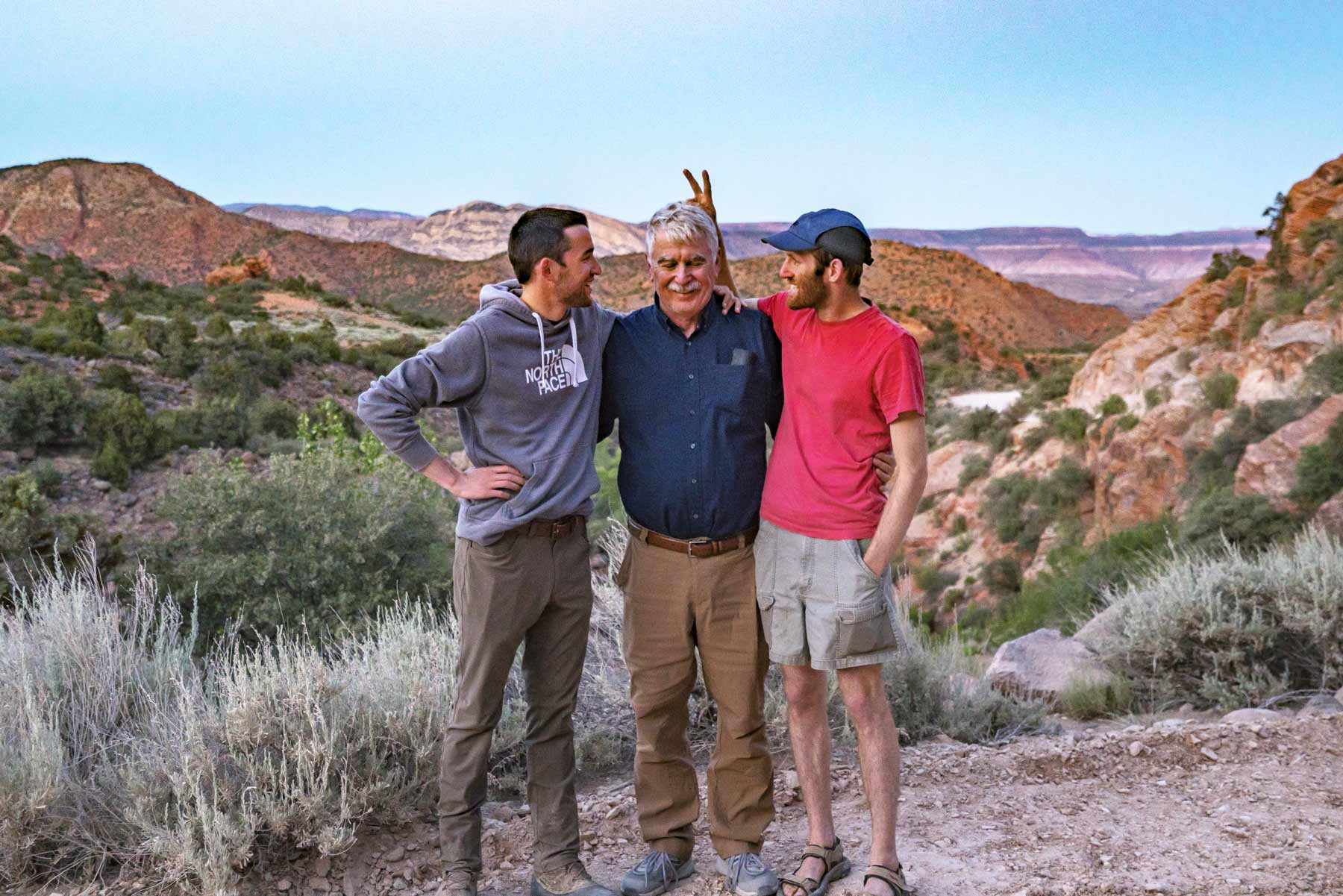
We’re Jim Pattiz and Will Pattiz, collectively known as the Pattiz Brothers.
Our goal here at More Than Just Parks is to share the beauty of America’s national parks and public lands through stunning short films in an effort to get Americans and the world to see the true value in land conservation.
If you’d like to follow along our journey we’d be delighted to have you!
And a bonus! Tips for Visiting a National Park
Permit Systems and Reservations
Check to see if the national park you’re visiting has a permit or reservation system in place before visiting. As parks become increasingly crowded more has to be done to safeguard them which means controlling the hundreds of millions of people who visit these places each year.
Popular national parks with reservation systems of some kind include Yosemite, Yellowstone, Zion, Rocky Mountain, Glacier, Arches, Acadia, Denali, and more.
Want Less Crowds? Try a National Forest!
Try visiting a national forest while you’re on your trip to avoid the crowds. There are 155 national forests in America, many of which are equally as beautiful as the national parks they neighbor and only see a fraction of the visitors.
For example, try the Flathead National Forest next to Glacier National Park, the Bridger-Teton next to Grand Teton, and the Dixie which borders nearly all of the Utah National Parks.
Practice Safety, Seriously
National parks are amazing but wild places so it is essential to practice basic safety while visiting them. Every year people die while vacationing in national parks. This is easily avoided by:
- Sticking to trails
- Checking the weather before going out on a hike
- Maintaining a safe distance between wildlife which means at least 25 yards from most wildlife and 100 yards from predators
- Avoid ledges with steep drop offs
Pin Tips for Visiting Mount Rushmore


More Helpful Articles
Mount Rushmore to Yellowstone: Driving Mount Rushmore to Yellowstone National Park Road Trip
Hiking the Castle Trail: Castle Trail: Epic Hikes in Badlands National Park (Photos + Guide)
Hiking the Notch Trail: Hiking the Notch Trail in Badlands National Park (Photos + Guide)
Best Hikes in Badlands: 15 Best Hikes in Badlands National Park
Badlands NP Guide: Helpful Guide to Badlands National Park
Things to Do in Badlands: 20 Incredible Things to Do in Badlands National Park
Black Hills National Forest: Comprehensive Guide to the Black Hills National Forest
Things to Do Yellowstone: 15 BEST Things to Do Yellowstone National Park
Yellowstone Facts: 10 AMAZING Yellowstone National Park Facts
Best Airports Near Yellowstone: The BEST Airports Near Yellowstone National Park
The Wyoming National Parks: 10 EPIC Wyoming National Parks: The Complete Guide (+ Photos)
South Dakota National Parks: 6 Epic South Dakota National Parks Worth Visiting
South Dakota Landmarks: 15 Amazing South Dakota Landmarks to See
South Dakota Historical Sites: 15 Incredible South Dakota Historical Sites


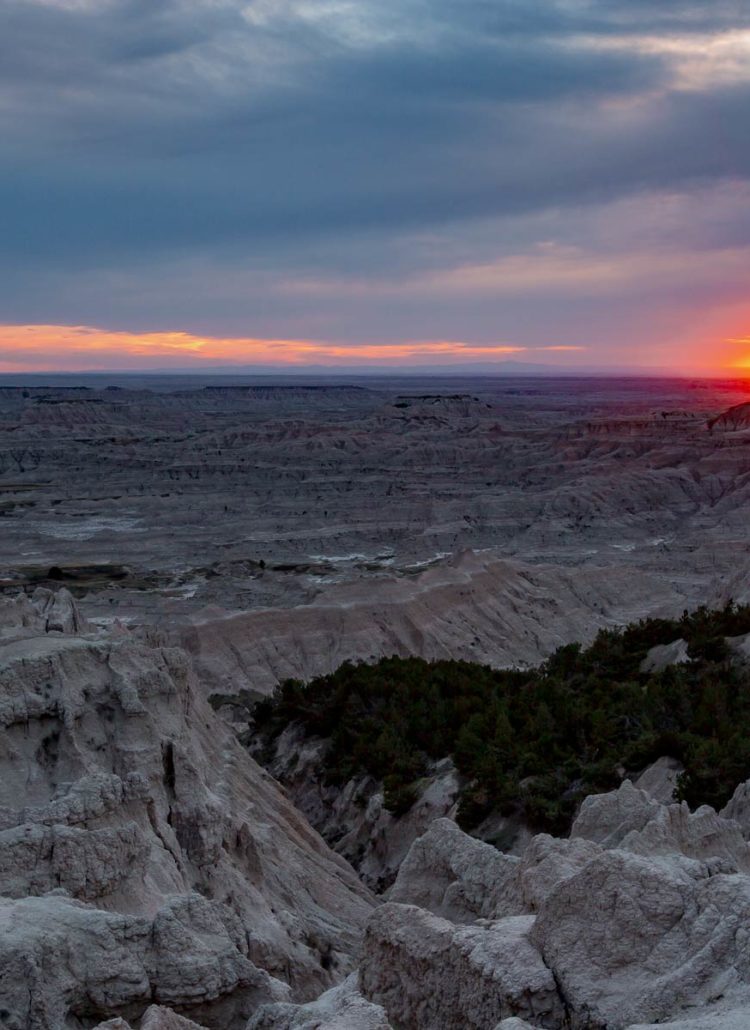
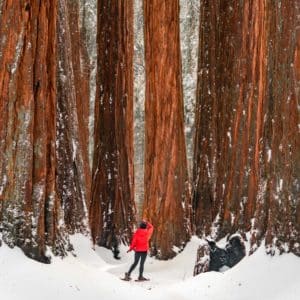

Very informative. Thanks for all the great tips and places to visit. Can’t wait to book my trip
Thank you for all this great information. We are planning a trip soon and it’s been on my to do list for basically my lifetime. I’ve just never made it there and this year I’m doing it even if I have to do it alone.
Thanks again, I appreciate your detailed information.
Regards,
Brenda